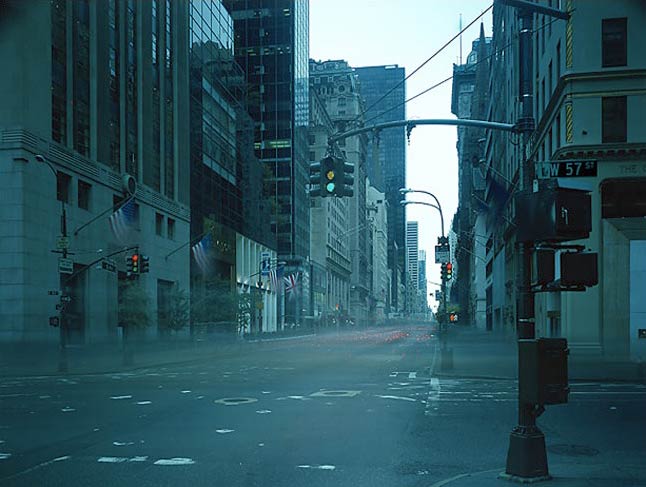within the world

Recent psychological research suggests that people from Western, educated, industrialized, rich, and democratic societies — WEIRD, for short — not only live differently from the vast majority of the world’s population, but think differently too.
The unsettling realization for psychologists — the vast majority of whom are WEIRD themselves — is that they don’t actually know much about how the rest of the world thinks. A recent study by Joseph Henrich, Steven Heine, and Ara Norenzayan at the University of British Columbia notes that in the top international journals in six fields of psychology from 2003 to 2007, 68 percent of subjects came from the United States — and a whopping 96 percent from Western, industrialized countries. In one journal, 67 percent of American subjects and 80 percent of non-American subjects were undergraduates in psychology courses.
Does this really matter? Aren’t we all the same, after all? Not really, it turns out. WEIRDos tend to be more individualistic and more competitive than people from non-industrialized Asian and African societies. In tests measuring how groups of people work together, Westerners — and Americans in particular — are far more likely to look out for themselves. They even perceive space differently. When viewing the classic Müller-Lyer illusion (>–< vs. <-->), Americans are far more often and more easily fooled than Africans, possibly as a consequence of living in a world of concrete square angles rather than natural shapes.
{ Foreign Policy | Continue reading }
economics, ideas, within the world | January 13th, 2011 11:51 am

The Wikileaks Files, Volume whatever
(…)
1. North Korea, complete arseholes–even the Chinese have outgrown them.
2. Russia, a whole country run like The Sopranos only with less charm and public spiritedness.
3. Iran, such manifest dips***s that even their neigbhours want them dead.
(…)
Assange, in my opinion, has always been a stalking horse for anti-Americanism (not that that’s particularly surprising, America-haters are cheap as chips). But what’s helpful about this situation, from an American public relations perspective, is the sight of the likes of Michael Moore, Ken Loach and John Pilger rushing to this cretin’s defence claiming that the CIA has put these two women up to it in order to smear Assange. Yeah, right, I’d sooner believe the CIA had recruited Bin Laden’s beard-trimmer than these two Swedish lefties. It wasn’t his looks these women admired it was his politics; they don’t appear to bear any ideological grudge against him, it’s just that he’s the ‘worst screw ever‘ (which apparently is against the law in Sweden).
{ Kings of war | Continue reading }
related { What Psychology Could Add to the Wikileaks Debate | Big Think }
haha, within the world | January 12th, 2011 7:21 pm

It has been a year since I drove a cab, but the old garage still looks the same. (…)
Shape-up time at Dover Taxi Garage #2 still happens every afternoon, rain or shine, winter or summer, from two to six. That’s when the night-line drivers stumble into the red-brick garage on Hudson Street in Greenwich Village and wait for the day liners, old-timers with backsides contoured to the crease in the seat of a Checker cab, to bring in the taxis. The day guys are supposed to have the cabs in by four, but if the streets are hopping they cheat a little bit, maybe by two hours. That gives the night liners plenty of time to stand around in the puddles on the floor, inhale the carbon monoxide, and listen to the cab stories.
Cab stories are tales of survived disasters. They are the major source of conversation during shape-up. (…)
A year ago or so, any woman hanging out at shape-up was either waiting to report a driver for stealing her pocketbook, a Dover stiff’s girl friend, or some sort of crazy cabdriver groupie. In those days, the two or three women who were driving were banned from the night line, which is notably unfair because you can make a lot more money with a lot less traffic driving at night. Claire, a long-time Dover driver, challenged the rule and won; now fifteen women drive for Dover, most on the night line. (…)
It doesn’t take a cabdriver too long to realize that once you leave the joy of shape-up and start uptown on Hudson Street, you’re fair game. You’re at the mercy of the Fear Variables, which are (not necessarily in order): the traffic, which will be in your way; the other cabdrivers, who want to take your business; the police, who want to give you tickets; the people in your cab, lunatics who will peck you with nudges and dent you with knives; and your car, which is capable of killing you at any time. Throw in your bosses and the back inspectors and you begin to realize that a good night is not when you make a living wage. That’s a great night. A good night is when you survive to tell your stories at tomorrow’s shape-up. But all the Fear Variables are garbage compared with the Big Fear. The Big Fear is that times will get so hard that you’ll have to drive five or six nights a week instead of three.
{ NY mag | Continue reading }
Of the many thousands of events canceled by the snow, it might have been convenient if Friday’s scheduled rollout of the great New York share-a-taxicab-with-a-stranger experiment of 2010 were not among them.
Alas.
Communal rides in the city’s yellow cab fleet will now start Wednesday, the Taxi and Limousine Commission said.
The share-a-cab program will allow up to four passengers to ride carpool-style along three preset routes in Manhattan, at a flat fare of $3 or $4 a head. Drop-offs will be allowed along Park Avenue down to Grand Central Terminal. For now, shared rides will only be allowed between 6 and 10 a.m. on weekdays.
{ NY Times | Continue reading }
photo { David Stewart }
experience, new york, transportation | January 12th, 2011 6:57 pm

Bob spoke about how people tend to walk faster in larger cities, with this relationship surprisingly consistent. (…)
The early movers in this area of research were Bornstein and Bornstein, who between 1972 and 1974 went to 15 countries across Europe, North America and Asia and measured the speed of pedestrians. They took a 50 feet stretch in similar downtown areas of each city and measured the speed of single, unencumbered walkers traversing that distance.
The slowest walkers were from Itea, Greece (population 2,500), who took an average of 22 seconds to cover the 50 feet. In Prague, a city of over 1 million, the pedestrians covered the distance in a flying average of 8.5 seconds.
{ Jason Collins | Continue reading }
related { Peter Jacques Band, Walking on music, 1979 }
science, within the world | January 11th, 2011 10:12 am

Sometime in late 2011, according to the UN Population Division, there will be seven billion of us. (…)
Leeuwenhoek concluded there couldn’t be more than 13.385 billion people on Earth—a small number indeed compared with the 150 billion sperm cells of a single codfish! This cheerful little calculation, writes population biologist Joel Cohen in his book How Many People Can the Earth Support?, may have been the first attempt to give a quantitative answer to a question that has become far more pressing now than it was in the 17th century. Most answers these days are far from cheerful.
And the explosion, though it is slowing, is far from over. Not only are people living longer, but so many women across the world are now in their childbearing years—1.8 billion—that the global population will keep growing for another few decades at least. (…)
With the population still growing by about 80 million each year, it’s hard not to be alarmed. Right now on Earth, water tables are falling, soil is eroding, glaciers are melting, and fish stocks are vanishing. Close to a billion people go hungry each day. Decades from now, there will likely be two billion more mouths to feed, mostly in poor countries. There will be billions more people wanting and deserving to boost themselves out of poverty. If they follow the path blazed by wealthy countries—clearing forests, burning coal and oil, freely scattering fertilizers and pesticides—they too will be stepping hard on the planet’s natural resources. How exactly is this going to work?
{ National Geographics | Continue reading }
photo { Andres Gonzalez }
uh oh, within the world | January 10th, 2011 1:30 am

The Soviet and Japanese threats to American supremacy proved chimerical. (…) The Chinese challenge to the United States is more serious for both economic and demographic reasons. The Soviet Union collapsed because its economic system was highly inefficient, a fatal flaw that was disguised for a long time because the USSR never attempted to compete on world markets. China, by contrast, has proved its economic prowess on the global stage. Its economy has been growing at 9 to 10 percent a year, on average, for roughly three decades. It is now the world’s leading exporter and its biggest manufacturer, and it is sitting on more than $2.5 trillion of foreign reserves. Chinese goods compete all over the world. This is no Soviet-style economic basket case.
Japan, of course, also experienced many years of rapid economic growth and is still an export powerhouse. But it was never a plausible candidate to be No. 1. The Japanese population is less than half that of the United States, which means that the average Japanese person would have to be more than twice as rich as the average American before Japan’s economy surpassed America’s. That was never going to happen. By contrast, China’s population is more than four times that of the United States. The famous projection by Goldman Sachs that China’s economy will be bigger than that of the United States by 2027 was made before the 2008 economic crash. At the current pace, China could be No. 1 well before then.
{ Foreign Policy | Continue reading }
photo { Christopher Schreck }
U.S., asia, economics, within the world | January 10th, 2011 1:25 am
ideas, new york, photogs | December 17th, 2010 4:40 pm

The belief culture thrives on the false principle that all opinions are equal, even those without a shred of factual data, documentation, or reasoned methodology. It is a culture in which one in 20 Americans believe NASA faked the Apollo moon landings, and half the population believes the world was made in six days. (…)
There is a certain irony in the case of the United States, a nation founded on Enlightenment principles of rationality and now so eagerly becoming a culture of raw, unquestioning belief.
{ Utne | Continue reading }
U.S. | December 16th, 2010 7:05 pm

The Fundamental Rights Agency said the Czech Republic was the only EU country still using a “sexual arousal” test.
Gay asylum seekers are hooked up to a machine that monitors blood-flow to the penis and are then shown straight porn.
Those applicants who become aroused are denied asylum.
{ BBC | Continue reading }
photo { Markel Redond }
law, uh oh, within the world | December 13th, 2010 7:40 pm
drugs, economics, within the world | December 13th, 2010 7:25 pm

Gamers, as video-game players are known, thrill to “the pull,” that mysterious ability that good games have of making you want to play them, and keep playing them.
Miyamoto’s games are widely considered to be among the greatest. He has been called the father of modern video games. The best known, and most influential, is Super Mario Bros., which débuted a quarter of a century ago and, depending on your point of view, created an industry or resuscitated a comatose one. It spawned dozens of sequels and spinoffs. Miyamoto has designed or overseen the development of many other blockbusters, among them the Legend of Zelda series, Star Fox, and Pikmin. Their success, in both commercial and cultural terms, suggests that he has a peerless feel for the pull, that he is a master of play—of its components and poetics—in the way that Walt Disney, to whom he is often compared, was of sentiment and wonder. (…)
What he hasn’t created is a company in his own name, or a vast fortune to go along with it. He is a salaryman. Miyamoto’s business card says that he is the senior managing director and the general manager of the entertainment-analysis and -development division at Nintendo Company Ltd., the video-game giant. What it does not say is that he is Nintendo’s guiding spirit, its meal ticket, and its playful public face. Miyamoto has said that his main job at Nintendo is ningen kougaku—human engineering. He has been at the company since 1977 and has worked for no other.
{ The New Yorker | Continue reading }
asia, economics, experience, leisure, technology, visual design | December 13th, 2010 7:20 pm
imp, new york | December 9th, 2010 10:20 am

{ The US authorities have discovered 20 tonnes of marijuana, worth tens of millions of dollars, in one of the most advanced illegal tunnels ever found. The passage is half a mile long and runs from inside a house in Mexico straight under the border with the United States and into a warehouse in San Diego. | BBC | video }
U.S., bridges and tunnels, drugs, law | December 9th, 2010 7:10 am

{ I came out the door the other day to find this girl sitting on my steps smoking a joint with a friend. She apologized for smoking there and I said there was no problem until there was a problem which she seemed to like. I told her I liked her tattoos and asked if I could take her picture. She seemed flattered. While photographing her I asked how the LAPD liked her tattoos and she said “Yeah…they like to photograph them too.” | Tracy photographed by Stephen Zeigler }
l.a. pros and cons, photogs | December 8th, 2010 10:26 pm

{ the adventures of imp on 6th avenue, december 7, 2010, 11pm }
imp, new york | December 8th, 2010 10:21 pm

Human intelligence is puzzling. It is higher, on average, in some places than in others. And it seems to have been rising in recent decades. Why these two things should be true is controversial. This week, though, a group of researchers at the University of New Mexico propose the same explanation for both: the effect of infectious disease. If they are right, it suggests that the control of such diseases is crucial to a country’s development in a way that had not been appreciated before. Places that harbour a lot of parasites and pathogens not only suffer the debilitating effects of disease on their workforces, but also have their human capital eroded, child by child, from birth.
{ The Economist | Continue reading }
photo { Raquel Nave, Live Free In Hell | more | Interviews & Photos: The Contributing Editor, Vogue Italy }
health, photogs, science, within the world | December 6th, 2010 10:35 pm

Niagara Falls’ descent into blight—in spite of its proximity to an attraction that draws at least 8 million tourists each year—is a tale that Hudson’s little newspaper has been telling for years. It encompasses just about every mistake a city could make, including the one Frankie G. cited: a 1960s mayor’s decision to bulldoze his quaint downtown and replace it with a bunch of modernist follies. There was a massive hangar-like convention center designed by Philip Johnson; Cesar Pelli’s glassy indoor arboretum, the Wintergarden, which was finally torn down because it cost a fortune to heat through the Lake Erie winter; a shiny office building known locally as the “Flashcube,” formerly the headquarters of a chemical company and now home to a trinket market. Once a hydropowered center of industry, Niagara Falls is now one of America’s most infamous victims of urban decay, hollowed out by four decades of job loss, mafia infiltration, political corruption, and failed get-fixed-quick schemes. Ginger Strand, author of Inventing Niagara: Beauty, Power, and Lies, called the place “a history in miniature of wrongheaded ideas about urban renewal.”
{ BusinessWeek | Continue reading }
photo { Paul Rodriguez }
U.S., economics, scams and heists | December 6th, 2010 9:00 pm

Women are getting as good as they’re giving. By ages 25-29, 88 percent say they’ve received oral sex from a man, and 72 percent say they’ve received it in the last year. (…)
In 1992, 16 percent of women aged 18-24 said they’d tried anal sex. Now 20 percent of women aged 18-19 say they’ve done it, and by ages 20-24, the number is 40 percent. In 1992, the highest percentage of women in any age group who admitted to anal sex was 33. In 2002, it was 35. Now it’s 46. (…)
Among women who had vaginal sex in their last encounter, the percentage who said they reached orgasm was 65. Among those who received oral sex, it was 81. But among those who had anal sex, it was 94. Anal sex outscored cunnilingus.
No way, you say. Way. Read the data.
{ Slate | Continue reading }
U.S., sex-oriented | December 4th, 2010 6:26 pm

The name “Ukraine” literally translates as “on the edge.” It is a country on the edge of other countries, sometimes part of one, sometimes part of another and more frequently divided. In the 17th and 18th centuries, it was divided between Russia, Poland and the Ottoman Empire. In the 19th century, it was divided between Russia and Austria-Hungary. And in the 20th century, save for a short period of independence after World War I, it became part of the Soviet Union. Ukraine has been on the edge of empires for centuries.
{ George Friedman | Continue reading }
within the world | December 4th, 2010 5:52 pm

Chinese netizens have already started selecting the Internet catchphrases of 2010. (…)
Geili Geili used to be a word only spoken in the northern dialect literally meaning “giving power,” but is now widely accepted as an adjective describing something “cool,” “awesome,” or “exciting.” Its antonym “bugeili” means “far from desirable,” “dull” or “boring.”
Magic horse is just floating cloud. “Magic horse” actually does not refer to a horse, but is rather a homophone of “shen me” meaning “what.” “Magic horse” replaced its predecessor “xia mi” as the most popular phrase in the Chinese Internet community shortly after its emergence. “Floating cloud” here indicates “purely imaginary” or “disappearing quickly.” Altogether, the phrase means “nothing is worth mentioning.”
{ People Daily | Continue reading }
Linguistics, asia, horse | December 2nd, 2010 8:00 pm






















